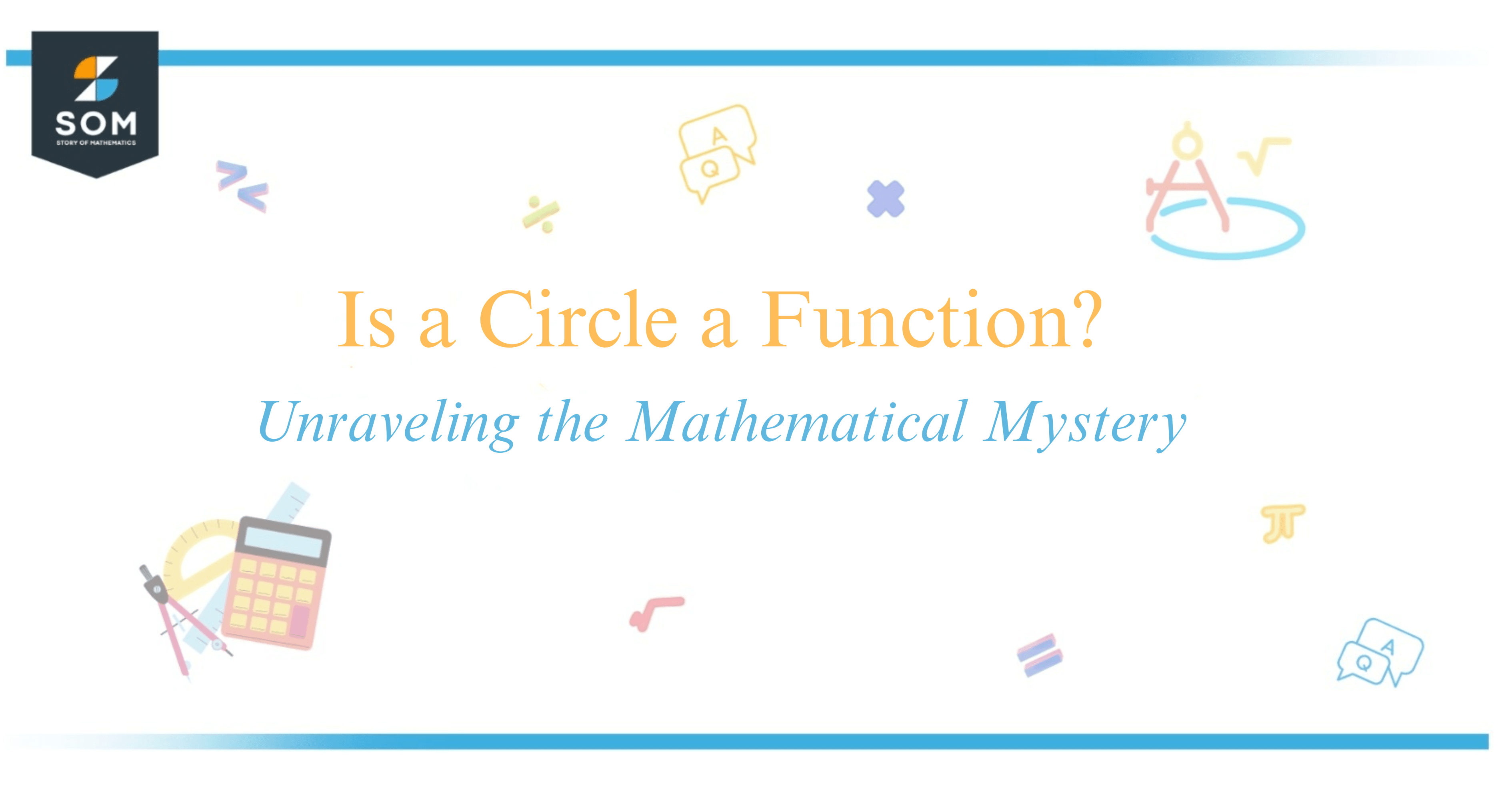JUMP TO TOPIC

No, a circle is not a function. A fundamental characteristic of a function in mathematics is that every input is associated with exactly one output.
However, the equation of a circle—$x^2 + y^2 = r^2$ where (r) is the radius—does not satisfy this criterion. When we solve for (y), we obtain two values, $y = \sqrt{r^2 – x^2}$ and $y = -\sqrt{r^2 – x^2}$, for a given (x) within the domain of the circle.
This implies that for some values of (x), there are two corresponding (y) values, which violates the definition of a function.
Despite this, the concept of a circle is deeply integrated into various areas of mathematics, including geometry and trigonometry. Circles are associated with circular functions, which represent the position of a point traveling around the circumference of a circle.
These circular functions can be expressed as mathematical functions. As we explore the relationship between circles and functions, I’ll show you how the equation of a circle differs from that of a function, and how both play crucial roles in understanding mathematical concepts.
Determining if a Circle is a Function
When I consider the equation of a circle, I recall that it’s generally expressed as $(x-h)^2 + (y-k)^2 = r^2$, where $h$ and $k$ are the coordinates of the center and $r$ is the radius.
To explore whether a circle constitutes a function, I look at the definition of a function in the context of a Cartesian plane.

A function, in a mathematical sense, assigns exactly one output (or y-value) for every input (or x-value) within its domain. So, for me to categorize a relationship as a function, each variable in the domain can correspond to one and only one value in the range.
Now, analyzing this in relation to a circle‘s equation, I notice a complication. If I solve for y, I end up with two solutions: $y = k + \sqrt{r^2 – (x-h)^2}$ and $y = k – \sqrt{r^2 – (x-h)^2}$.
This indicates that for some values of x, there are two different y-values. Hence, a full circle doesn’t meet the criteria of a function because it fails the vertical line test.
However, if I look at circular functions, like sine and cosine, which emerge from the unit circle where $r=1$, I acknowledge that they do qualify as functions.
They assign one y-value (for sine) or one x-value (for cosine) for every angle (which acts as the input variable), maintaining a distinct range of possible outputs.
In essence, while a circle itself isn’t a function, the circular functions based on its geometry are valid members of the function family.
The Circle Equation and Its Components
When I look at the equation of a circle, I see it as the set of all points that maintain a constant distance, known as the radius, from a fixed point called the center. The standard form of a circle’s equation is represented as $(x – h)^2 + (y – k)^2 = r^2$, where ((h, k)) are the coordinates of the center and (r) is the radius.
To elaborate, (x) and (y) are variables that denote any point on the circle, and (h) and (k) are constants representing the center‘s coordinates. Here (x) is the abscissa and (y) is the ordinate. The radius is the distance from the center to any point on the circle.
The general form of a circle’s equation can be expressed as $ x^2 + y^2 + 2gx + 2fy + c = 0$. In this form, the center is found at ( (-g, -f) ) and the radius is calculated by the equation $r = \sqrt{g^2 + f^2 – c}$.
Here’s a table summarizing the components of the circle equation:
| Component | Standard Form | General Form |
|---|---|---|
| Center | ((h, k)) | ((-g, -f)) |
| Radius | (r) | $\sqrt{g^2 + f^2 – c}$ |
By simply adjusting the values of (h), (k), and (r) in the standard form, or (g), (f), and (c) in the general form, I can describe any circle within a coordinate system.
Each value plays a crucial role in defining the size and position of a circle, ensuring that the equation ties back precisely to those geometric features we’re familiar with.
Graphing and Analyzing Circles
When I graph a circle, I start with its standard equation, which has the form $x^2 + y^2 = r^2$, where ( r ) represents the radius of the circle.
This equation shows that for a given radius, there’s a set of points (( x,y )) that are equidistant from the center. In other words, all points that solve this equation will lie on the circle.
To analyze a circle on a graph, it’s important to note that a circle does not represent a function in terms of ( y ) being a unique output for each ( x ) input.
A function must pass the vertical line test, meaning a vertical line drawn at any ( x ) value should cross the graph at no more than one point. However, a circle will meet a vertical line at two points in most cases (except at the points where ( x = \pm r )), indicating it’s not a function of ( x ).
Here’s a quick reference table for circle attributes:
| Attribute | Description | Mathematical Representation |
|---|---|---|
| Center | The point from which all points on the circumference are equidistant | ( (h, k) ) |
| Radius | Distance from the center to any point on the circle | ( r ) |
| Equation | The formula representing all the points of the circle | $x^2 + y^2 = r^2$ for center at origin |
So, when I plot the points of a circle on a graph, I’m essentially drawing the image of all the solutions to its equation. By carefully choosing variables ( x ) and calculating the corresponding ( y ) variables, I can visualize the shape of the circle. This circle can then be considered a locus of points that maintains a constant distance, ( r ), from the center.
Conclusion
In exploring the characteristics of a function, I’ve found that by strict definition, a circle does not qualify. This is because a function must have exactly one output value for each input value.
When considering a circle equation, such as $x^2 + y^2 = r^2$, where $r$ is the radius, I notice that for a given value of $x$, there can be two possible values of $y$. For instance, if $x$ is half the radius, the associated $y$ values will be $\sqrt{r^2 – x^2}$ and $-\sqrt{r^2 – x^2}$.
This fails the vertical line test, a method for determining if a curve is a function. In the context of a circle, any vertical line passing through the center will intersect it in two points.
Hence, the full circle cannot be considered a function. However, either the upper or lower semicircle could be described by function equations $y = \sqrt{r^2 – x^2}$ and $y = -\sqrt{r^2 – x^2}$ respectively because each $x$ in their domains would correspond to a single $y$ value.
Understanding this helps clarify the relationship between circle equations and function requirements. Conforming to mathematical precision enhances my appreciation for the nuances of mathematics and its language.
